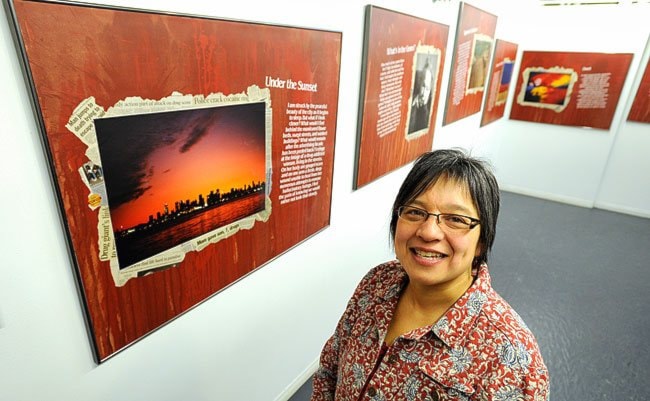Many artists figuratively put their own blood, sweat and tears into their projects, but Leslie Leong did it literally.
Every one of the 25 pieces in her exhibit, Blood-letting: A Rite of Purification, contains a tiny bit of her own blood.
“Some people asked me during the opening if it was painted with all my blood,” said Leong. “I said, ‘no, I’d probably be dead.’”
But there’s another reason. The background of each piece is painted to look like dripping blood. But real blood on a canvas doesn’t look how you might expect.
“It’s actually kind of interesting,” she said. “The colour of blood is actually really dark, I never realized.
“It’s not like in the movies.”
For Leong, who is no fan of needles, it was a bit of an ordeal to get it.
The hospital in Fort Smith, N.W.T. , where she was living at the time, refused to draw blood because of liability issues. Ultimately Leong convinced the local midwife, who had delivered the first of her two children, to do the deed.
She mixed two vials of blood into the paint she used for the background.
It was an act that helped Leong deal with the sombre nature of the project.
“I felt that there needed to be a physical component of it too,” she said.
“I guess emotionally that’s what this exhibit was for me, purging that depressing stuff out of me because if you hold it it’s going to do you some damage.”
Creating the exhibit was a melancholy process, said Leong.
She started by collecting a mountain of magazines and newspapers from friends and the library.
“We generally know what’s going on, but the experience of actually going through all those periodicals and reading them I guess gave it more reality or something,” she said. “I found it very depressing because, of course, the stuff that gets into the periodicals are mostly not good stories.”
[image2]
When she saw a story related to a theme that she wanted to explore, she would rip it out and put it aside.
“So I had all those files and it was very clear that all the violence and all the awful stuff were way bigger files than the ones that were kind of nice stories that were about the positive side of the human spirit,” said Leong.
Each piece is a large original photograph framed by a collage of headlines torn from various periodicals. It’s all on a canvas painted to look like dripping blood with a short paragraph next to each photo that unambiguously describes the essence of the piece.
The words are the focal point of the pieces, said Leong.
“Most exhibits you just go and get a visual impression and experience it that way, but this one’s not really meant to be that way,” she said. “It’s meant to be something that you spend time with.
“You need to read it because that’s what it’s about.”
Each piece is meant to explore a problem, an issue or an injustice.
Fine Balance, which is represented by a large colour photograph of a Athabaskan sand dune framed by headlines of violence and tragedy, represents the struggle of both societies and individuals to find balance in life.
“I don’t know anybody that doesn’t struggle with trying to maintain or define that balance in everything we do, in our relationship with others, with the environment, all of that,” said Leong. “I think as a result we’re not content and what results from that is, in many cases, violence.”
The show is designed to get people talking.
“That was the intent of the exhibit in the first place, to be able to look at these ideas and to ponder them. Because we need to do that, to acknowledge they are issues and then we can so something about it,” she said. “It’s the first step to making change.
“The hope I guess for people to be more intentional in their living and be more conscious of things.”
With 25 pieces in the exhibit, it’s a lot to take in, which is why Leong also produced a small “meditation book” with photographs of the entire exhibit for people to take home.
The exhibit is actually almost a decade old, although it’s the first time that it has been shown in the Yukon.
It was first put on display in the Northwest Territories, where Leong was living at the time.
Leong and her family moved to the Yukon three years ago after spending several years living near her husband’s family in Australia.
“I had always wanted to show it outside of the Northwest Territories, so this was a good place to start,” she said.
Showing the exhibit again was, in some ways, kind of sad, said Leong.
“The depressing part of bringing it out of the box is that I don’t think things are very different,” she said. “All the same stuff is still going on.”
Blood-letting: A Rite of Purification opened last Friday and will be on display at Gallery 22 - just above Triple J’s Music Cafe - until Feb. 3.
Contact Josh Kerr at
joshk@yukon-news.com
